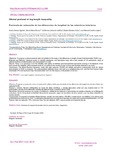Mostrar o rexistro simple do ítem
Protocolo de valoración de las diferencias de longitud de los miembros inferiores
| dc.contributor.author | Gómez-Aguilar, Estela | |
| dc.contributor.author | Reina Bueno, María | |
| dc.contributor.author | Lafuente-Sotillos, Guillermo | |
| dc.contributor.author | Montes-Salas, Rubén | |
| dc.contributor.author | Castillo-López, José Manuel | |
| dc.date.accessioned | 2018-04-03T11:48:00Z | |
| dc.date.available | 2018-04-03T11:48:00Z | |
| dc.date.issued | 2017 | |
| dc.identifier.citation | European Journal of Podiatry 2017, 3: 18-25 ISSN: 2445-1835 | |
| dc.identifier.issn | 2445-1835 | |
| dc.identifier.uri | http://hdl.handle.net/2183/20360 | |
| dc.description.abstract | [Abstract] Objectives: To propose a clinical protocol valid and reliable for the study of the differences in length of lower limb (hereinafter DLMI) scan.Materials and Methods: Literature review in scientific databases, and descriptive study with a total sample of 115 participants: study of different methods of determination and measurement of DLMI.Results: There is no consensus as to the reliability and validity of methods and measurement instruments existing in the literature. It has been proven the reliability of the proposed protocol, according to the results of other authors and the data obtained in our study.Conclusions: The Weber-Barstow maneuver, study with tape measure, PALM® and tablets and pelvic compensation level for clinical determination of DLMI is proposed. The anteroposterior telemetry lower limb load as a complementary test, and the Foot Posture Index (hereinafter FPI) and Navicular Drop Test (hereinafter NDT) for the analysis of the position of the foot[Resumen] Objetivos: Proponer un protocolo clínico de exploración válido y fiable para el estudio de las diferencias de longitud de miembro inferior (en adelante DLMI).Material y método: Revisión bibliográfica en bases de datos científicas, y estudio descriptivo sobre con una muestra total de 115 participantes: estudio de los diferentes métodos de determinación y medición de las DLMI.Resultados: No existe consenso en cuanto a la fiabilidad y validez de los métodos e instrumentos de medida existentes en la bibliografía consultada. Se ha comprobado la fiabilidad del protocolo propuesto, según los resultados de otros autores y por los datos obtenidos en nuestro estudio.Conclusiones: Se propone la maniobra Weber-Barstow, estudio con cinta métrica, PALM® y compensación con tablillas y nivel pélvico para la determinación clínica de las DLMI. La telemetría anteroposterior de miembros inferiores en carga como prueba complementaria, y el Foot Posture Index (en adelante, FPI) y Navicular Drop Test (en adelante, NDT) para el análisis de la posición del pie | |
| dc.language.iso | spa | |
| dc.publisher | Universidade da Coruña | |
| dc.relation.uri | http://dx.doi.org/10.17979/ejpod.2017.3.1.1565 | |
| dc.subject | Leg length Inequality | |
| dc.subject | Clinical protocol | |
| dc.subject | Diagnosis | |
| dc.subject | Diferencia de longitud del miembro inferior | |
| dc.subject | Protocolo clínico | |
| dc.subject | Diagnóstico | |
| dc.title | Protocolo de valoración de las diferencias de longitud de los miembros inferiores | |
| dc.title.alternative | Clinical protocol of leg length inequality | |
| dc.type | info:eu-repo/semantics/article | |
| dc.rights.access | info:eu-repo/semantics/openAccess | |
| UDC.journalTitle | European Journal of Podiatry | |
| UDC.volume | 3 | |
| UDC.issue | 1 | |
| UDC.startPage | 18 | |
| UDC.endPage | 25 |






